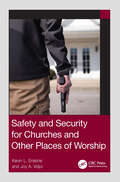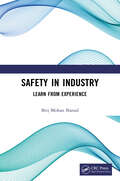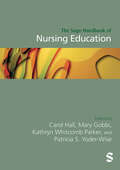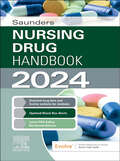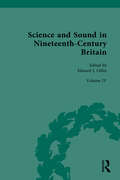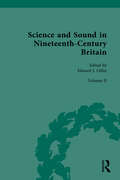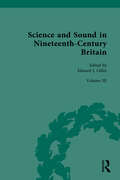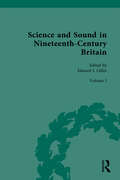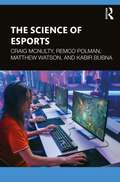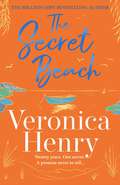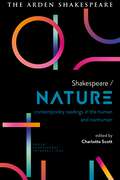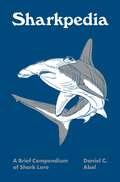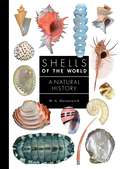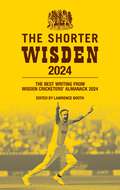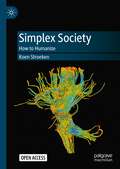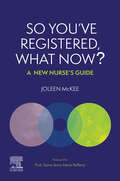- Table View
- List View
Safety and Security for Churches and Other Places of Worship
by Kevin L. Erskine Joy A. VolpiSafety and Security for Churches and Other Places of Worship is a reference book focused on how to form a first responder team for churches, synagogues, temples, and other places of worship. It will assist team leaders on how to train for both security and medical emergencies, provide training aids and ideas, and how to write SOPs and legal issues. Trending violence directed at soft targets is growing, forcing places of worship to respond with highly trained personnel to quickly intervene. Many medical incidents can have drastically better outcomes if trained medical personnel render immediate medical care. For instance, the use of an AED in conjunction with CPR can drastically improve survival rates from 15% to 85%, versus just CPR alone. Topics covered include: Environmental disasters Acts of violence Active shooter incidents Bomb threats Unruly/disruptive persons Suspect control Sexual abuse Realistic training using fake wounds Tabletop exercises Team building Medical emergencies An equipment chapter helps to determine what equipment is a priority for teams limited by budget. Some equipment can mean the difference between a "friend" being mistaken for an aggressor, resulting in an innocent person being injured or killed. Safety and Security for Churches and Other Places of Worship is a must-have reference for anyone charged with the duty to protect those who attend and work at places of worship.
Safety in Industry: Learn from Experience
by Brij Mohan BansalThis concise book presents years of the author’s practical experiences on industrial safety through various case studies. It aims to quip professionals in their respective industrial fields with different safety management systems, like the knowledge of common dos and don’ts, Standard Operating Procedures (SOP), and even the Emergency handling and use of PPEs. Print edition not for sale in South Asia (Bangladesh, Bhutan, India, Nepal, Pakistan and Sri Lanka)
Safety in Industry: Learn from Experience
by Brij Mohan BansalThis concise book presents years of the author’s practical experiences on industrial safety through various case studies. It aims to quip professionals in their respective industrial fields with different safety management systems, like the knowledge of common dos and don’ts, Standard Operating Procedures (SOP), and even the Emergency handling and use of PPEs. Print edition not for sale in South Asia (Bangladesh, Bhutan, India, Nepal, Pakistan and Sri Lanka)
The Sage Handbook of Nursing Education
by Carol Hall Patricia S. Yoder-Wise Mary Gobbi Kathryn Whitcomb ParkerIn the past several years, a revival of research devoted to nursing education has emerged. This emergence has changed the way many educators engage in their practice of working with learners; and learners have come to expect that they will have a rich learning experience designed to develop new (or enhance prior) knowledge, skills, and attitudes. The SAGE Handbook of Nursing Education provides a detailed map of the current discipline, with a carefully selected team of international contributors offering the latest thinking about education in nursing across key areas. This handbook will be a key resource for academic educators, as well as graduate and postgraduate learners.
The Sage Handbook of Nursing Education
In the past several years, a revival of research devoted to nursing education has emerged. This emergence has changed the way many educators engage in their practice of working with learners; and learners have come to expect that they will have a rich learning experience designed to develop new (or enhance prior) knowledge, skills, and attitudes. The SAGE Handbook of Nursing Education provides a detailed map of the current discipline, with a carefully selected team of international contributors offering the latest thinking about education in nursing across key areas. This handbook will be a key resource for academic educators, as well as graduate and postgraduate learners.
The Sage Handbook of Nursing Education
by Carol Hall Patricia S. Yoder-Wise Mary Gobbi Kathryn Whitcomb ParkerIn the past several years, a revival of research devoted to nursing education has emerged. This emergence has changed the way many educators engage in their practice of working with learners; and learners have come to expect that they will have a rich learning experience designed to develop new (or enhance prior) knowledge, skills, and attitudes. The SAGE Handbook of Nursing Education provides a detailed map of the current discipline, with a carefully selected team of international contributors offering the latest thinking about education in nursing across key areas. This handbook will be a key resource for academic educators, as well as graduate and postgraduate learners.
Saunders Nursing Drug Handbook 2024 - E-Book
by Robert Kizior Keith HodgsonMore than 1,000 generic name drugs, encompassing over 4,000 trade name drugs, are organized alphabetically with A-to-Z tabs for quick and easy access. UNIQUE! Herbal information is included in the appendix and on the Evolve website, covering the interactions and effects of commonly encountered herbs. Detailed information for each drug includes side effects listed by frequency, and adverse effects and reactions requiring prompt intervention. Drugs by Disorder are listed in the front of the book for easy reference, showing common disorders and the drugs most often used for treatment. Drug Classifications section features an overview of actions and uses for drug families. Black Box Alerts and High Alert drugs are highlighted to promote safe administration of drugs that pose the greatest risk for patient harm, and Do Not Confuse With warnings call out drug names that sound alike or look alike. Top 100 Drugs list helps you easily identify the most frequently administered drugs. Cross-references to the 400 top U.S. brand-name drugs are located throughout the book for easy access. List of newly approved medications in the front of the book makes it easy to locate the latest drugs. Nursing considerations are organized in a functional nursing process framework and include baseline assessment, intervention/evaluation, and patient/family teaching. Information on lifespan and disorder-related dosage variations covers special considerations for pediatric, geriatric, hepatic, and immune- or renal-compromised patients. Extensive IV content includes IV compatibilities/IV incompatibilities and breaks down key information on reconstitution, rate of administration, and storage, as well as an IV Compatibility Chart foldout covering 65 intravenous drugs. Customizable and printable monographs for 100 of the most commonly used drugs are located on Evolve. NEW! Drug monographs for 12 new FDA-approved medications equip you with the most current drug information. NEW! Updates include uses, dosage forms, interactions, precautions, and other need-to-know information to help prevent medication dispensing errors.
Science and Sound in Nineteenth-Century Britain: Sound Transformer (Nineteenth-Century Science, Technology and Medicine: Sources and Documents #4)
Sound and Science in Nineteenth-Century Britain is a four-volume set of primary sources which seeks to define our historical understanding of the relationship between British scientific knowledge and sound between 1815 and 1900. In the context of rapid urbanization and industrialization, as well as a growing overseas empire, Britain was home to a rich scientific culture in which the ear was as valuable an organ as the eye for examining nature. Experiments on how sound behaved informed new understandings of how a diverse array of natural phenomena operated, notably those of heat, light, and electro-magnetism. In nineteenth-century Britain, sound was not just a phenomenon to be studied, but central to the practice of science itself and broader understandings over nature and the universe. This collection, accompanied by extensive editorial commentary, will be of great interest to students and scholars of the History of Science.
Science and Sound in Nineteenth-Century Britain: Philosophies and Epistemologies of Sound (Nineteenth-Century Science, Technology and Medicine: Sources and Documents #2)
by Edward J. GillinScience and Sound in Nineteenth-Century Britain is a four-volume set of primary sources which seeks to define our historical understanding of the relationship between British scientific knowledge and sound between 1815 and 1900. In the context of rapid urbanization and industrialization, as well as a growing overseas empire, Britain was home to a rich scientific culture in which the ear was as valuable an organ as the eye for examining nature. Experiments on how sound behaved informed new understandings of how a diverse array of natural phenomena operated, notably those of heat, light, and electro-magnetism. In nineteenth-century Britain, sound was not just a phenomenon to be studied, but central to the practice of science itself and broader understandings over nature and the universe. This collection, accompanied by extensive editorial commentary, will be of great interest to students and scholars of the History of Science.
Science and Sound in Nineteenth-Century Britain: Sound in Context (Nineteenth-Century Science, Technology and Medicine: Sources and Documents #3)
by Edward J. GillinScience and Sound in Nineteenth-Century Britain is a four-volume set of primary sources which seeks to define our historical understanding of the relationship between British scientific knowledge and sound between 1815 and 1900. In the context of rapid urbanization and industrialization, as well as a growing overseas empire, Britain was home to a rich scientific culture in which the ear was as valuable an organ as the eye for examining nature. Experiments on how sound behaved informed new understandings of how a diverse array of natural phenomena operated, notably those of heat, light, and electro-magnetism. In nineteenth-century Britain, sound was not just a phenomenon to be studied, but central to the practice of science itself and broader understandings over nature and the universe. This collection, accompanied by extensive editorial commentary, will be of great interest to students and scholars of the History of Science.
Science and Sound in Nineteenth-Century Britain: Sound in Context (Nineteenth-Century Science, Technology and Medicine: Sources and Documents #3)
Science and Sound in Nineteenth-Century Britain is a four-volume set of primary sources which seeks to define our historical understanding of the relationship between British scientific knowledge and sound between 1815 and 1900. In the context of rapid urbanization and industrialization, as well as a growing overseas empire, Britain was home to a rich scientific culture in which the ear was as valuable an organ as the eye for examining nature. Experiments on how sound behaved informed new understandings of how a diverse array of natural phenomena operated, notably those of heat, light, and electro-magnetism. In nineteenth-century Britain, sound was not just a phenomenon to be studied, but central to the practice of science itself and broader understandings over nature and the universe. This collection, accompanied by extensive editorial commentary, will be of great interest to students and scholars of the History of Science.
Science and Sound in Nineteenth-Century Britain: Philosophies and Epistemologies of Sound (Nineteenth-Century Science, Technology and Medicine: Sources and Documents #2)
Science and Sound in Nineteenth-Century Britain is a four-volume set of primary sources which seeks to define our historical understanding of the relationship between British scientific knowledge and sound between 1815 and 1900. In the context of rapid urbanization and industrialization, as well as a growing overseas empire, Britain was home to a rich scientific culture in which the ear was as valuable an organ as the eye for examining nature. Experiments on how sound behaved informed new understandings of how a diverse array of natural phenomena operated, notably those of heat, light, and electro-magnetism. In nineteenth-century Britain, sound was not just a phenomenon to be studied, but central to the practice of science itself and broader understandings over nature and the universe. This collection, accompanied by extensive editorial commentary, will be of great interest to students and scholars of the History of Science.
Science and Sound in Nineteenth-Century Britain: Sound Transformer (Nineteenth-Century Science, Technology and Medicine: Sources and Documents #4)
by Edward J. GillinSound and Science in Nineteenth-Century Britain is a four-volume set of primary sources which seeks to define our historical understanding of the relationship between British scientific knowledge and sound between 1815 and 1900. In the context of rapid urbanization and industrialization, as well as a growing overseas empire, Britain was home to a rich scientific culture in which the ear was as valuable an organ as the eye for examining nature. Experiments on how sound behaved informed new understandings of how a diverse array of natural phenomena operated, notably those of heat, light, and electro-magnetism. In nineteenth-century Britain, sound was not just a phenomenon to be studied, but central to the practice of science itself and broader understandings over nature and the universe. This collection, accompanied by extensive editorial commentary, will be of great interest to students and scholars of the History of Science.
Science and Sound in Nineteenth-Century Britain: Sounds Experimental and Entertaining (Nineteenth-Century Science, Technology and Medicine: Sources and Documents #1)
Sound and Science in Nineteenth-Century Britain is a four-volume set of primary sources which seeks to define our historical understanding of the relationship between British scientific knowledge and sound between 1815 and 1900. In the context of rapid urbanization and industrialization, as well as a growing overseas empire, Britain was home to a rich scientific culture in which the ear was as valuable an organ as the eye for examining nature. Experiments on how sound behaved informed new understandings of how a diverse array of natural phenomena operated, notably those of heat, light, and electro-magnetism. In nineteenth-century Britain, sound was not just a phenomenon to be studied, but central to the practice of science itself and broader understandings over nature and the universe. This collection, accompanied by extensive editorial commentary, will be of great interest to students and scholars of the History of Science.
Science and Sound in Nineteenth-Century Britain: Sounds Experimental and Entertaining (Nineteenth-Century Science, Technology and Medicine: Sources and Documents #1)
by Edward J. GillinSound and Science in Nineteenth-Century Britain is a four-volume set of primary sources which seeks to define our historical understanding of the relationship between British scientific knowledge and sound between 1815 and 1900. In the context of rapid urbanization and industrialization, as well as a growing overseas empire, Britain was home to a rich scientific culture in which the ear was as valuable an organ as the eye for examining nature. Experiments on how sound behaved informed new understandings of how a diverse array of natural phenomena operated, notably those of heat, light, and electro-magnetism. In nineteenth-century Britain, sound was not just a phenomenon to be studied, but central to the practice of science itself and broader understandings over nature and the universe. This collection, accompanied by extensive editorial commentary, will be of great interest to students and scholars of the History of Science.
The Science of Esports
by Craig McNulty Remco Polman Matthew Watson Kabir BubnaThe Science of Esports draws from contemporary research and coach expertise to examine esports athlete health and performance from a range of disciplinary perspectives, including physiology, psychology, sociology, and nutrition. The rapid expansion of the esports industry has elevated competitive video gaming into the realm of high performance, requiring players, coaches, and practitioners to implement interdisciplinary approaches to performance support. The book covers key topic areas such as: What esports is and similarities and differences to sport Game-specific training Physiological and psychological consideration for esports athletes Social aspects of player performance and the social environment of esports Esports coaching and structure of esports performance environments Technology and its use in esports Safeguarding, cheating, and gambling This book includes worked examples and case studies to allow immediate implementation into practice for esports athletes and coaches. It summarises the current state of research to inform researchers and identify gaps in knowledge. This book is critical reading for students of esports and related courses. It serves as the first scientific resource designed to provide athletes, coaches, and practitioners with interdisciplinary insights into esports health and performance.
The Science of Esports
by Craig McNulty Remco Polman Matthew Watson Kabir BubnaThe Science of Esports draws from contemporary research and coach expertise to examine esports athlete health and performance from a range of disciplinary perspectives, including physiology, psychology, sociology, and nutrition. The rapid expansion of the esports industry has elevated competitive video gaming into the realm of high performance, requiring players, coaches, and practitioners to implement interdisciplinary approaches to performance support. The book covers key topic areas such as: What esports is and similarities and differences to sport Game-specific training Physiological and psychological consideration for esports athletes Social aspects of player performance and the social environment of esports Esports coaching and structure of esports performance environments Technology and its use in esports Safeguarding, cheating, and gambling This book includes worked examples and case studies to allow immediate implementation into practice for esports athletes and coaches. It summarises the current state of research to inform researchers and identify gaps in knowledge. This book is critical reading for students of esports and related courses. It serves as the first scientific resource designed to provide athletes, coaches, and practitioners with interdisciplinary insights into esports health and performance.
The Secret Beach: The stunning, escapist and gorgeously romantic new novel from the Sunday Times bestselling author
by Veronica HenryTHE STUNNING AND ROMANTIC NEW NOVEL FROM SUNDAY TIMES BESTSELLING AUTHOR VERONICA HENRY!'Dreamy and irresistible!' JILL MANSELL'A summery tale of intrigue, family drama and romance. I loved it!' SARAH MORGANTwenty years.One secret.A promise never to tell...Nikki finally owns the little coastguard cottage of her dreams - and it's a few steps away from the hidden beach that means so much to her.But when a handwritten note lands on her doorstep, she realises it's only a matter of time before the heartbreaking truth of her past is uncovered.Twenty years ago, her whole world was turned upside-down when a terrible storm rolled into the small seaside town of Speedwell.Ever since that night, Nikki has been keeping a secret. One she knows has the potential to destroy the lives of those she loves most.Because as sure as the tide turns, there are no secrets in a small town...Your favourite authors love The Secret Beach:'What an amazing book! Veronica always delivers a cracking read, but this is exceptional' MILLY JOHNSON'Family secrets, a beautiful Cornish setting and a beach like no other... I was swept away!' LUCY DIAMOND'Captivating and romantic. I completely fell in love with Speedwell' HEIDI SWAIN'A wonderful treat of a read!' SUE MOORCROFT'A story filled with so much heart. Simply gorgeous!' LIZ FENWICK'Warm, wise, and completely wonderful. I now want to move to Speedwell immediately' ALEX BROWN
Shakespeare / Nature: Contemporary Readings in the Human and Non-human (Arden Shakespeare Intersections)
by Lucy Munro Professor Sonia Massai Dr Farah Karim Cooper Professor Gordon McMullanShakespeare / Nature sets new agendas for the study of nature in Shakespeare's work. Offering a rich exploration of the intersections between the human and non-human worlds, the chapters focus on the contested and persuasive language of nature, both as organic matter and cultural conditioning.Rooted in close textual analysis and historical acuity, this collection addresses Shakespeare's works through the many ways in which 'nature' performs, as a cultural category, a moral marker and a set of essential conditions through which the human may pass, as well as affect. Addressing the complex conditions of the play worlds, the chapters explore the assorted forms through which Shakespeare's nature makes sense of its narratives and supports, upholds or contests its story-telling. Over the course of the collection, the contributors examine plays including Macbeth, Julius Caesar, The Tempest, The Taming of the Shrew, Othello, Love's Labour's Lost, Hamlet, Timon of Athens and many more. They discuss them through the various lenses of philosophy, historicism, psychoanalysis, gender studies, cosmography, geography, sexuality, linguistics, environmentalism, feminism and robotics, to provide new and nuanced readings of the intersectional terms of both meaning and matter.Approaching 'nature' in all its multiplicity, this collection sets out to examine the divergent and complex ways in which the human and non-human worlds intersect and the development of a language of symbiosis that attempts to both control and create the terms of human authority. It offers an entirely new approach to the subject of nature, bringing together disparate methods that have previously been pursued independently to offer a shared investment in the intersections between the human and non-human worlds and how these discourses shape and condition the emotional, organic, cultural and psychological landscapes of Shakespeare's play worlds.
Sharkpedia: A Brief Compendium of Shark Lore (Pedia Bks. #13)
by Daniel AbelA fun, pocket-size A–Z treasury about sharks, featuring fascinating, little-known facts and captivating illustrationsSharkpedia is an entertaining and enlightening celebration of sharks featuring close to 100 entries, based on the latest knowledge and enriched by original illustrations. Avoiding tired factoids, shark authority Daniel Abel gives new bite to essential information about sharks, including their adaptations as top predators, 450-million-year evolution, behavioral complexity, ecological importance, existential threats, and often sensationalized appearances in popular culture, from Jaws to Shark Week.The notion that sharks are insatiable killing machines is a toothless myth—yet the fear of shark attacks still holds on to many people like a set of locked jaws. Sharkpedia reveals that sharks are much less to be feared—and much more interesting, complicated, and important—than many realize. Filled with compelling stories, Sharkpedia debunks shark myths (for example, that sharks are large and coastal when in fact most are small and inhabit the deep sea), describes their lives (where and how long they live, how many offspring they have, what they eat, and how their bodies function), introduces a variety of iconic and obscure species (such as the Happy Eddie Shyshark), explores our love/hate relationship with sharks, and much more.With charming drawings by leading shark artist Marc Dando, Sharkpedia is a scientific and cultural treasure trove that will leave you with new insights about these remarkable animals. Dive in!Features a cloth cover with an elaborate foil-stamped design
Sharkpedia: A Brief Compendium of Shark Lore (Pedia Bks. #13)
by Daniel AbelA fun, pocket-size A–Z treasury about sharks, featuring fascinating, little-known facts and captivating illustrationsSharkpedia is an entertaining and enlightening celebration of sharks featuring close to 100 entries, based on the latest knowledge and enriched by original illustrations. Avoiding tired factoids, shark authority Daniel Abel gives new bite to essential information about sharks, including their adaptations as top predators, 450-million-year evolution, behavioral complexity, ecological importance, existential threats, and often sensationalized appearances in popular culture, from Jaws to Shark Week.The notion that sharks are insatiable killing machines is a toothless myth—yet the fear of shark attacks still holds on to many people like a set of locked jaws. Sharkpedia reveals that sharks are much less to be feared—and much more interesting, complicated, and important—than many realize. Filled with compelling stories, Sharkpedia debunks shark myths (for example, that sharks are large and coastal when in fact most are small and inhabit the deep sea), describes their lives (where and how long they live, how many offspring they have, what they eat, and how their bodies function), introduces a variety of iconic and obscure species (such as the Happy Eddie Shyshark), explores our love/hate relationship with sharks, and much more.With charming drawings by leading shark artist Marc Dando, Sharkpedia is a scientific and cultural treasure trove that will leave you with new insights about these remarkable animals. Dive in!Features a cloth cover with an elaborate foil-stamped design
Shells of the World: A Natural History (A Guide to Every Family #10)
by M. G. HarasewychA marvelously illustrated natural history of the world&’s mollusksMollusks are invertebrate animals with a remarkable natural history and a rich fossil record, and their shells are prized for their breathtaking variety and exquisite beauty. Shells of the World provides a wide-ranging look at the incredible diversity of marine mollusks. An informative introduction outlines the lineages covered, followed by a directory section, split into classes, that profiles a broad selection of different taxa to give a sense of their sheer numbers and variety.Features hundreds of beautiful color photos, depicting both the live animals and their shellsDiscusses mollusk evolution, anatomy, life cycles, behavior, and ecologyDescribes unique characteristics, distribution, habitat, and sizeProvides valuable insights into the conservation of the world&’s marine mollusksIdeal for malacologists and shell collectors everywhere
The Shorter Wisden 2024: The Best Writing from Wisden Cricketers' Almanack 2024
by John Wisden CoThe most famous sports book in the world, Wisden Cricketers' Almanack has been published every year since 1864. The selected writings from the 161st edition contained in this eBook offer trenchant opinion, compelling features and an authoritative voice on the worldwide game.The Shorter Wisden is a distillation of what's best in its bigger brother – and the 2024 edition of Wisden is crammed, as ever, with the best writing in the game. Wisden's digital version includes the influential Notes by the Editor, and all the front-of-book articles. In essence, The Shorter Wisden is a glass of the finest champagne rather than the whole bottle. In an age of snap judgments, Wisden's authority and integrity are more important than ever. Yet again this year's edition is truly a “must-have” for every cricket fan.@WisdenAlmanack
Simplex Society: How to Humanize
by Koen StroekenThis open access book provides thought-provoking anthropology grounded in comparative ethnography. The theory captures the current historical moment, the long-term trends that led us here, and the prospects for a humane future. The experience of complexity characterizing a globalized information society triggers simplexes. These unidimensional responses instrumental in bringing about a predictable effect are altering our ways of communicating and the technologies we design. In Part I, a ‘speciated’ history, injected with the anthropology of Bateson and Gluckman, describes the semantic and experiential impoverishment of the lifeworld. After going through the affects of distrust (the neolithic lifeway), of futility (industrial lifeway) and disconnection (post-knowledge), the human species today depends for its survival on installing a new lifeway, which manages to wed (eco-social) inclusion to the already difficult first pair of the French Revolution. The species needs to rehumanize. Part II illustrates the remedies currently developed: to reframe, re-sphere and re-source. What do critical street art, international football matches, presidential elections, hip-hop dissing performances, charismatic church services, intuition stimulation, and ‘pre-ceptive’ experiences of consciousness have in common? They are moments of the real. Rooted in ‘life sensing’, they are tensors organizing frameshift. As multiplex measures tackling the simplex, these tensors overcome the cultural relativism of the postmodern matrix.
So You’ve Registered, What Now? - E-Book: A New Nurse’s Guide.
by Joleen McKeeFull of real-life tips and insights from practising nurses, this new title gives encouragement and advice to help newly qualified registrants prepare as they start work in the ever-changing world of health care. So You've Registered, What Now? does not cover clinical skills but rather concentrates on the practical essentials of working as a nurse in different settings, from hospitals to the community and research sectors. Written in an easy to follow, conversational style, it takes the reader through relevant regulations and provides up-to-date guidance on how to survive as a nurse in the real world. Being a newly registered nurse can be a daunting experience. New nurses will find this book an invaluable resource that will help them navigate the sometimes convoluted path to establishing their career, as well as a support and guide through the highs and lows of their working life. Current regulations and policies, and how to navigate them Definitions of technical terms and abbreviations Tips from nurses’ lived experience Discussion of preceptorship, nursing during the COVID-19 pandemic, and reflection
